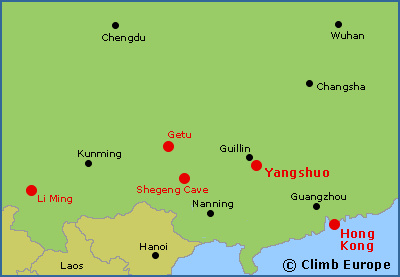Rock climbing in China
The potential for rock climbing in China is huge, though only a few places being developed into major climbing destinations. The main climbing destinations in China are Yangshuo and Hong Kong, but places such as Shegeng Cave, Li Ming and the Getu Valley are also being developed.
Yangshuo is by far the largest developed sport climbing destination in China, and is justifiably popular. The stunning scenery is famous for its limestone karst towers that dominate the skyline creating a world class sport climbing destination.
The sport climbing found at Yangshuo has something for everyone, with routes ranging from F4 to F9. There is also a wide range climbing styles found at Yangshuo from steep pumpy tufas, to technical crimpy face climbs and 3D body torqueing routes.
Yangshuo Rock is the comprehensive guidebook describing nearly 800 sport routes across 40 different crags. Buy this Yangshuo Rock guidebook from our shop. The best time to go rock climbing at Yangshuo is from September through to March, with the best conditions in December and January. Find out more about sport climbing at Yangshuo…
Map of the main rock climbing areas in China

Rock climbing in Hong Kong
Hong Kong is not your obvious sport climbing destination but situated just outside the city are numerous crags scattered around Hong Kong Island, Kowloon and Lantau Island. The unique aspect of Hong Kong climbing is the ease of access to individual areas and the proximity of the crags to the city. There are very few other cities in Asia where you can be at the foot of a crag, within literally 10 to 20 minutes of leaving the centre of Hong Kong.
The type of rock found on Hong Kong is either granite or volcanic tuff that produce well featured technical routes requiring good finger strength and footwork. Typically, the routes are up to 20m high, though there are some longer routes around 30m long, plus some multi-pitch routes up to 5 pitches on Lion rock. There are over 1,700 routes at Hong Kong spread across 67 different crags, covering a wide range of grades from F3 to F8a. There are many routes in the lower to mid-grade range offering a good variety of routes for the visiting or regionally based climber.
Hong Kong is also one of Asia’s premier bouldering destinations. Hong Kong bouldering comes in all different shades and sizes, from butt dragging low balls to terrifying high wall, featureless slabs to overhanging jug-fests, and everything in between. There are around 1,400 established boulder problems in Hong Kong, ranging from VB to 12, though the vast majority are in the V1 to V7 grade range.
When to climb in Hong Kong: November to February is the best time to climb at Hong Kong when the humidity and temperature is low.
What climbing guidebooks are available for Hong Kong:
Hong Kong Rock is the comprehensive guidebook covering 1,700 sport crags across 67 different crags. The guidebook covers a wide range of grades from F3 to F8a, with many routes in the lower to mid-grade range. Published in 2023, all the routes are shown on colour photo topos, along with a short description, the number of bolts and the pitch length.
Hong Kong Bouldering is the comprehensive guidebook detailing the bouldering to be found on Hong Kong, covering over 1,300 problems from VB to V12, spread across 14 different crags.
What gear is required: For most of the routes in Hong Kong a 50m rope is ideal though it is recommended to take a 70m rope if planning on doing some of the longer routes plus around 20 quickdraws.
How good is the bolting: The majority of Hong Kong’s routes have recently been re-bolted with either marine grade stainless steel or titanium resin (glue-in) bolts and local climbers support an active bolt fund.
Rock climbing in the Getu Valley
The Getu Valley is located in a beautiful mountainous region of Southern China. The climbing is on bullet-hard karst limestone rock with a wide variety of styles and grades. This includes everything from long slabs and vertical walls to tufa filled overhangs, including a Great Arch where many of the harder routes are. There are over 200 sport routes at Getu ranging from F5+ to F9a, including some multi-pitch routes up to 180m long.
The crags are split between those found within walking distance of the town and those in the Getu River National Park (where the Great Arch is). It is necessary to purchase a visitor’s pass to gain entry into the National Park, with all the climbing found a short boat trip across the river. With regards to gear a 70 or 80m rope is required plus at least 16 quickdraws.
Rock climbing at Li Ming
Li Ming is located high in the Verdant Mountains of Southern China’s Yunnan Province. Li Ming is a crack climbing wonderland that is quickly becoming China’s premier trad climbing destination.
Li Ming village is dwarfed by massive sandstone cliffs that hug the skyline. Currently there are around 180 routes of trad climbing, most of them cracks, offwidths or Chimneys. The size of these cracks requires the climber to be able to use finger, hand and fist jams – sometimes all in the same route.
Rock climbing at Shegeng Cave
Shegeng Cave, located in Fengshan County, in southern China, is a world-class climbing site known for its unique limestone karst landscape. This huge overhanging cave has many steep and overhanging walls, creating many hard routes. In fact, Shegeng Cave, hosts China’s first F9b route, called "El Gran Cabrón", established by Seb Bouin.